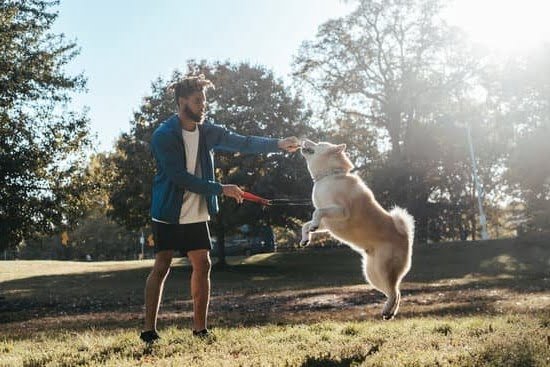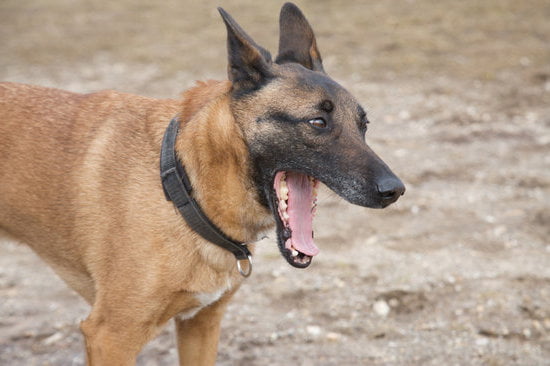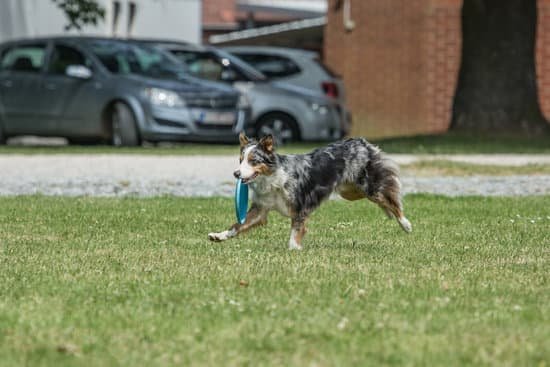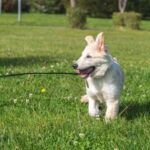Introduction
Over the years, many dog owners have noticed their pets’ habit of eating grass. There’s been a lot of speculation regarding why dogs eat grass, but there is some general consensus that it helps them remove indigestible contents from their stomachs and provides occasional extra nutrition. Despite these potential benefits to eating grass, there are still problems associated with dogs grazing on lawns. Common concerns include consuming weedkillers or pesticides, toxoplasmosis from feral cats and other gastrointestinal issues like choking or vomiting.
Training your dog to stop eating grass can be beneficial in various ways including: reducing the likelihood of gastrointestinal angiosarcomas (tumors) due to ingestion of lawn chemicals; helping to reduce the spread of toxoplasmosis; and providing owners with an alternative action for a bored or anxious animal. However, certain misconceptions and myths about training a dog can be quite common; for example, some people think that annoying their pet by spraying water or hitting them will somehow discourage them from trying to eat grass again. This type of approach is not recommended as it can result in more behavioral problems and further damage the human-animal bond.
The Causes of Dogs Eating Grass
There are a variety of causes of grass-eating behavior in dogs, though the most common explanations include nutrition-related issues such as boredom or nutritional deficiencies, medical conditions such as gastrointestinal upset like irritation or parasites, and environmental factors. Nutrition-related problems such as boredom can be addressed by providing your dog with more interactive toys and food puzzles to stimulate their minds. Nutritional deficiencies should be evaluated by a veterinarian who can make dietary changes to ensure your pup is getting all the necessary nutrients from his diet. If your dog has an underlying medical condition which is causing him to eat grass then these must be ruled out before other solutions can be tried.
Environmental factors may also contribute to why some dogs eat grass. Dogs that are under-stimulated and have access to lots of outdoor space may have developed a habit of eating grass for fun or entertainment. Restricting their time outdoors so that they only get to go out for potty breaks may help reduce the urge to graze on greenery.
Although all dog breeds may exhibit this behavior, certain breeds are more prone to it than others, such as Hounds, Retrievers and Setters. If your pup belongs to any of these breeds it’s important to identify the cause behind their grass-eating quickly and address it through appropriate solutions so that they don’t develop a strong taste for outdoor plants and dirt. With quick action and proper training, you should eventually be able to stop your pup from grazing on greenery.
Training Techniques
Positive reinforcement is an effective way to train a dog to stop eating grass. This technique involves rewarding the dog with treats and praise when he or she does not eat grass, rather than punishing him or her for doing so. If a dog is given food rewards for avoiding plants, this will help to create engagement in its owners and bring attention away from the plant material that the dog was considering consuming.
In addition to positive reinforcement, it can also be helpful to work on redirecting the dog’s focus. Whenever the dog appears distracted by the grass, it can be useful to immediately divert their attention with a ball or other toy instead. Playing fetch or another game should keep them occupied enough that they will forget about focusing on green material. Some dogs may take longer to learn full distraction training, but if positively rewarded when keeping their attentions focused on other activities, eventually it should catch on!
Last of all, it’s important to keep an eye out for underlying health issues that might be causing your pup to seek out plant-based meals. Urinary tract infections, a lack of minerals in daily rations, allergic reactions and even boredom have all been linked with a desire to eat lawn pleasures among many furry companions! Consulting with your vet about potential causes and treatments should certainly be part of any full strategy for teaching your pup proper grazing behaviour!
The Process of Training a Dog Not to Eat Grass
1. Start by understanding why your dog is eating grass. Grass eating is an instinct for some dogs and can be a sign of behavioral issues, dietary deficiencies, boredom or even anxiety. Make sure to speak with your veterinarian to make sure there are no underlying medical reasons (e.g., stomach upset).
2. Increase your dog’s quality of life by providing plenty of exercise and stimulation. For example, taking your dog on walks and playing interactive games such as fetch or puzzles can go a long way in keeping them entertained during the day.
3. Try different methods and techniques to stop your dog from eating grass including teaching basic commands such as “sit” and “leave it”, making use of an obedience lead when out walking or using treats as a reward for good behavior when out in the garden.
4. Restrict access to the source of the grass if you feel that this could be contributing to the problem; this may involve physically blocking off garden areas or using netting around plants that he likes to eat from along with engaging him in activities away from these areas that distract him from trying to get back into them.
5.When you catch your dog about to eat grass, discourage it with a verbal warning combined with redirecting his behavior toward something appropriate for chewing like a toy or treat (never hit or yell at your pet). Make sure he gets plenty of positive reinforcement each time he shows the correct behavior instead of eating grass. Remember – consistency is key when training any animal!
Alternative Solutions
Herbal Supplements: Some people prefer to give their dog herbal supplements as an alternative to traditional medication. These are available in various forms such as capsules, liquids, and chewable tablets. The most popular herbs which are said to help reduce the urge of dogs to eat grass include dandelion root extract, Saint John’s Wort, flaxseed oil, chamomile flower extract, black cohosh root extract, ashwagandha root extract, licorice root extract.
Dietary Adjustments: Another more natural approach that many owners opt for when trying to help reduce the desire of their dog to eat grass is adjusting their diet. This can involve providing them with high-quality proteins such as lean meats and a variety of nutritious vegetables that contain both insoluble and soluble fibers. Making sure your pup has enough fiber in their diet can help not only prevent digestive problems but also keep them from feeling the urge to consume grasses in search of nutrition. Additionally, some owners supplement their dog’s meals with green tripe that is full of natural enzymes and helps maintain a healthy gastrointestinal tract which improvements your pup’s digestive system overall.
Practical Tips for Training a Dog not to Eat Grass
When it comes to training a dog not to eat grass, there are a few practical tips to keep in mind. Firstly, it is important to recognize and avoid behaviors that may be confusing for your pet. For example, break the habit of throwing treats, toys, or other items on the ground outside; if these items are left on the lawn where your pet can access them and eat them along with grass, this might confuse them as to what is acceptable food and what isn’t.
Another tip for successful training is to use positive reinforcement and stop rewarding bad behavior. For example, when you see your pet eating grass give them verbal praise or rewards when they stop and try to distract their attention away from the grass with something else like a toy or treat. Consistency is key; if you don’t properly train and enforce good behavior by rewarding positive behaviors, undesirable behaviors like eating grass will likely continue.
Additionally, be sure to look out for signs of progress: if there has been reduced snacking on grass, less confusion regarding appropriate foods, or if they spend less time in areas prone to having lots of tempting greenery then that’s a good sign. Finally, observe how much time your pet spends wandering around outdoors; if the majority of their free time is spent inside it will help reduce their chance of coming into contact with grassy areas and reinforce that going outdoors does not always mean an opportunity for grazing.
Conclusion
When it comes to training your dog to stop eating grass, the most important piece of advice is to be consistent and patient. It’s essential to commit to long-term, consistent training for your pup so that their behavior can become a habit. Be sure to praise your pup every time they don’t snack on grass, offering positive reinforcement as this will help them begin to associate good things with not snacking on grass. Additionally, it’s best not to scold or punish your pup when they opt for Grass, as negative reinforcement will only worsen the problem.
By staying persistent with your training and following through with all that you have educated and trained your pup, in no time you will have a four-legged friend who will have learned that grass isn’t their treat and won’t be doing any more nibbling! The benefits of succeeding in this endeavour are immense; think of all the hours and energy you’ll save in future landscaping projects or avoiding veterinary bills caused by a possibly ill-fated grazing episode! Overall, being dedicated and devoted enough towards training your dog will continue to pay off from day one until many years past – and you’ll both be happy for it!

Welcome to the blog! I am a professional dog trainer and have been working with dogs for many years. In this blog, I will be discussing various topics related to dog training, including tips, tricks, and advice. I hope you find this information helpful and informative. Thanks for reading!





